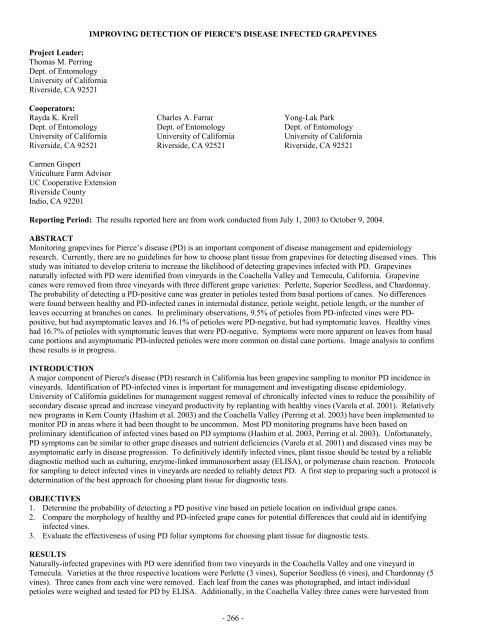Impact Of Host Plant Xylem Fluid On Xylella Fastidiosa Multiplication ...
Impact Of Host Plant Xylem Fluid On Xylella Fastidiosa Multiplication ...
Impact Of Host Plant Xylem Fluid On Xylella Fastidiosa Multiplication ...
You also want an ePaper? Increase the reach of your titles
YUMPU automatically turns print PDFs into web optimized ePapers that Google loves.
Project Leader:<br />
Thomas M. Perring<br />
Dept. of Entomology<br />
University of California<br />
Riverside, CA 92521<br />
IMPROVING DETECTION OF PIERCE'S DISEASE INFECTED GRAPEVINES<br />
Cooperators:<br />
Rayda K. Krell<br />
Dept. of Entomology<br />
University of California<br />
Riverside, CA 92521<br />
Carmen Gispert<br />
Viticulture Farm Advisor<br />
UC Cooperative Extension<br />
Riverside County<br />
Indio, CA 92201<br />
Charles A. Farrar<br />
Dept. of Entomology<br />
University of California<br />
Riverside, CA 92521<br />
Yong-Lak Park<br />
Dept. of Entomology<br />
University of California<br />
Riverside, CA 92521<br />
Reporting Period: The results reported here are from work conducted from July 1, 2003 to October 9, 2004.<br />
ABSTRACT<br />
Monitoring grapevines for Pierce’s disease (PD) is an important component of disease management and epidemiology<br />
research. Currently, there are no guidelines for how to choose plant tissue from grapevines for detecting diseased vines. This<br />
study was initiated to develop criteria to increase the likelihood of detecting grapevines infected with PD. Grapevines<br />
naturally infected with PD were identified from vineyards in the Coachella Valley and Temecula, California. Grapevine<br />
canes were removed from three vineyards with three different grape varieties: Perlette, Superior Seedless, and Chardonnay.<br />
The probability of detecting a PD-positive cane was greater in petioles tested from basal portions of canes. No differences<br />
were found between healthy and PD-infected canes in internodal distance, petiole weight, petiole length, or the number of<br />
leaves occurring at branches on canes. In preliminary observations, 9.5% of petioles from PD-infected vines were PDpositive,<br />
but had asymptomatic leaves and 16.1% of petioles were PD-negative, but had symptomatic leaves. Healthy vines<br />
had 16.7% of petioles with symptomatic leaves that were PD-negative. Symptoms were more apparent on leaves from basal<br />
cane portions and asymptomatic PD-infected petioles were more common on distal cane portions. Image analysis to confirm<br />
these results is in progress.<br />
INTRODUCTION<br />
A major component of Pierce's disease (PD) research in California has been grapevine sampling to monitor PD incidence in<br />
vineyards. Identification of PD-infected vines is important for management and investigating disease epidemiology.<br />
University of California guidelines for management suggest removal of chronically infected vines to reduce the possibility of<br />
secondary disease spread and increase vineyard productivity by replanting with healthy vines (Varela et al. 2001). Relatively<br />
new programs in Kern County (Hashim et al. 2003) and the Coachella Valley (Perring et al. 2003) have been implemented to<br />
monitor PD in areas where it had been thought to be uncommon. Most PD monitoring programs have been based on<br />
preliminary identification of infected vines based on PD symptoms (Hashim et al. 2003, Perring et al. 2003). Unfortunately,<br />
PD symptoms can be similar to other grape diseases and nutrient deficiencies (Varela et al. 2001) and diseased vines may be<br />
asymptomatic early in disease progression. To definitively identify infected vines, plant tissue should be tested by a reliable<br />
diagnostic method such as culturing, enzyme-linked immunosorbent assay (ELISA), or polymerase chain reaction. Protocols<br />
for sampling to detect infected vines in vineyards are needed to reliably detect PD. A first step to preparing such a protocol is<br />
determination of the best approach for choosing plant tissue for diagnostic tests.<br />
OBJECTIVES<br />
1. Determine the probability of detecting a PD positive vine based on petiole location on individual grape canes.<br />
2. Compare the morphology of healthy and PD-infected grape canes for potential differences that could aid in identifying<br />
infected vines.<br />
3. Evaluate the effectiveness of using PD foliar symptoms for choosing plant tissue for diagnostic tests.<br />
RESULTS<br />
Naturally-infected grapevines with PD were identified from two vineyards in the Coachella Valley and one vineyard in<br />
Temecula. Varieties at the three respective locations were Perlette (3 vines), Superior Seedless (6 vines), and Chardonnay (5<br />
vines). Three canes from each vine were removed. Each leaf from the canes was photographed, and intact individual<br />
petioles were weighed and tested for PD by ELISA. Additionally, in the Coachella Valley three canes were harvested from<br />
- 266 -











